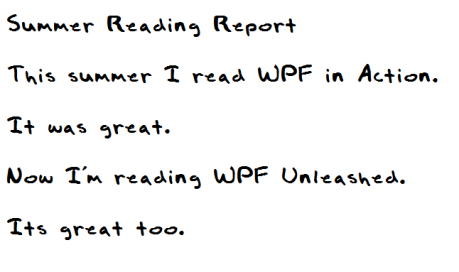ThreadCount
 I’m reading Concurrent Programming on Windows since everyone @Lab seems to know more about threading than I do. Like most of the books I’ve been reading lately, this one weighs in at about 1,000 pages. I’d recommend it for anyone who knows a bit about the concurrency infrastructure but wants to know it all. Even so, there were some places where I felt a detail was missing, but 1,000 pages is plenty.
I’m reading Concurrent Programming on Windows since everyone @Lab seems to know more about threading than I do. Like most of the books I’ve been reading lately, this one weighs in at about 1,000 pages. I’d recommend it for anyone who knows a bit about the concurrency infrastructure but wants to know it all. Even so, there were some places where I felt a detail was missing, but 1,000 pages is plenty.
Here’s some interesting things I learned in the first couple hundred pages.
New threads in .Net will allocate 1MB for the stack on creation.
The total processor limit (including logical processors) of 32/64 in windows is mostly because of the CPU affinity mask which is 32 or 64 bits depending on windows version. This paper (Windows Support for Hyper-Threading Technology) supports that statement for Windows 2003 server. I can’t find a good reference to support this for Windows Server 2008.
The native (OS) limit for waitable objects (WaitForMultipleObjects) is 64, but .Net supports more.
WPF Book Recommendations
 |
 |
Seriously, WPF in Action is a great first book on WPF. I suppose there’s a lot of choices for a first read in WPF.
WPF Unleashed is the in depth full treatment of WPF. It’s required reading for a full understanding of the subject.
It has great examples and uses its full color printing for maximum effect. Highly recommended.
SuperReading SuperFreakonomics
I’m reading SuperFreakonomics. It recommends drunk driving over drunk walking, tells that TV has empowered the women of India, points out the ridiculously low incidence of shark attacks, and the likelihood of the climate crisis being solved more cheaply than expected with new technology. That’s just in the introduction, where they also apologize for the last book not actually covering “everything.” Seems like the readers are taking the title too seriously.
None of that struck me as particularly odd, but on page 20 they mentioned “between the thirteenth and nineteenth centuries, as many as 1 million European women…were executed for witchcraft.” That number struck me as a bit high since only about 20 people were killed in the Salem Witch Hunt and that’s such a big deal that everybody knows about it. On the other hand, that’s an average of less than a couple thousand a year for all of Europe.
Looking at the Wikipedia entry, the number is 40,000 – 100,000 executions from 1480 – 1700, “the classical period of witchhunts”, by which I suppose they mean the hight of the hysteria. This makes it hard to believe the larger period had 1 Million deaths. Looking at the Levit & Dubner’s source, it says “as many as one million individuals…primarily women”. That’s only a slight deviation from the book. Reading the source, it seems pretty grim and believable. I’m not into researching the question further: obviously witch hunt deaths were far greater than I previously knew.
Freakonomics is a fun read and claims to use real data to explain things. I say claims because there might be some more significant inaccuracies.
I’m sure I’ll enjoy it anyway. The first book was great and the freakonomics blog is often interesting too.

